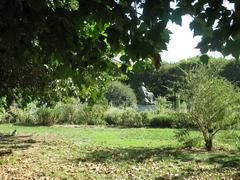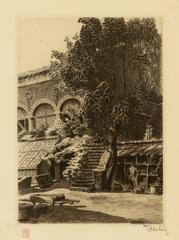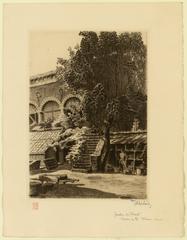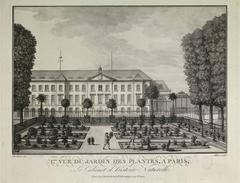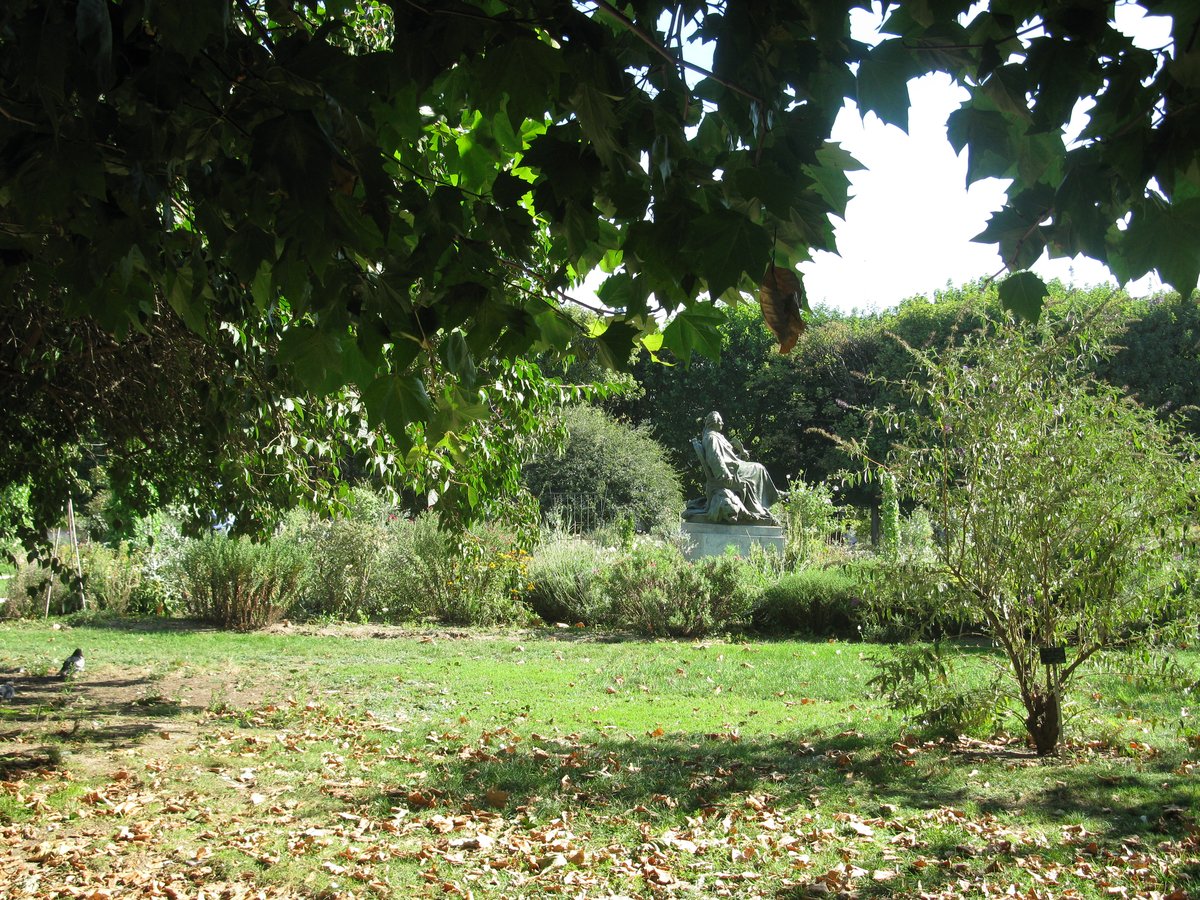
Jardin des Plantes Paris: Visiting Hours, Tickets, and Historical Significance Guide
Date: 14/06/2025
Introduction: What to Expect at the Jardin des Plantes
Located in Paris’s vibrant 5th arrondissement, the Jardin des Plantes is an exceptional blend of botanical splendor, scientific heritage, and cultural history. Established in 1635 as the Jardin royal des plantes médicinales under King Louis XIII, its original purpose was the cultivation of medicinal plants for medical training. Over the centuries, it has developed into one of the world’s leading botanical gardens and a vital component of the Muséum National d’Histoire Naturelle. Today, visitors can explore themed gardens with over 23,500 plant species, historic Art Deco greenhouses, engaging museums, and the famed Ménagerie—one of the world’s oldest zoos. The garden is also renowned for pioneering public scientific education and making scientific knowledge accessible to all (Muséum National d’Histoire Naturelle; Bonjour Paris). This guide covers the Jardin des Plantes’ history, visiting hours, ticketing, accessibility, travel tips, and nearby attractions to help you plan an unforgettable visit (Jardin des Plantes Official; Wikipedia).
Table of Contents
- Historical Overview
- Visitor Information
- Practical Tips and FAQs
- Conclusion and Recommendations
- Sources
Historical Overview
Royal Origins and Early Development (17th Century)
The Jardin des Plantes was founded in 1635, initially as a medicinal garden by royal decree. Guy de La Brosse, the king’s physician, became its first director, overseeing its design and early plantings. The garden opened to the public in 1640, offering free courses in anatomy, botany, and chemistry—remarkably taught in French rather than Latin, broadening access to scientific knowledge (mnhn.fr).
Enlightenment Expansion (18th Century)
During the Enlightenment, the garden gained international prestige. The Jussieu brothers, renowned botanists, spearheaded global plant collection and classification efforts. Under Georges-Louis Leclerc, Comte de Buffon, appointed in 1739, the garden doubled in size, acquired tree-lined promenades, and became a center for scientific research and leisure (bonjourparis.com).
Revolutionary Transformation (Late 18th Century)
The French Revolution transformed the garden into a public institution. In 1793, it merged with royal natural history collections to become the Muséum d’Histoire Naturelle. The Ménagerie zoo was established in 1794, making the Jardin des Plantes a pioneer in zoological study and public education (jardindesplantesdeparis.fr).
19th–21st Century: Conservation, Education, and Modernization
The 19th century saw the addition of architectural masterpieces such as the Grande Galerie de Minéralogie and the Grande Galerie de l’Évolution. Specialized gardens and greenhouses emphasized biodiversity and research. Today, the garden covers 28 hectares, houses one of the world’s largest herbaria, and plays a key role in conservation, education, and community engagement (jardiplante.fr; Britannica).
Visitor Information
Visiting Hours
- Outdoor Gardens: Open daily from 7:30 am to 8:00 pm (seasonal variations apply; check the official website for updates).
- Museums, Ménagerie (Zoo), and Grandes Serres (Greenhouses): Open Tuesday–Sunday, 10:00 am to 6:00 pm; closed Mondays.
- Special events (like the Festival of Lights) may have extended or separate hours (World in Paris).
Tickets & Admission
- Main Gardens: Free entry.
- Greenhouses: €7 for adults; discounts for youth and seniors.
- Ménagerie (Zoo) & Museums: Combined ticket approx. €13; discounts and family passes available.
- Special Events: Separate ticket required (e.g., Festival of Lights).
- Tickets are available online (Jardin des Plantes Official Tickets) or at the entrance. Booking ahead is advised during peak periods.
Accessibility
- Most main paths and attractions are wheelchair accessible; some older buildings and the Alpine Garden may pose challenges.
- Wheelchairs are available for loan; contact +33 (0)1 40 79 56 01.
- Service animals are permitted; regular pets are not.
Getting There & Travel Tips
- Address: 57 Rue Cuvier, 75005 Paris.
- Metro: Jussieu (Lines 7, 10), Gare d’Austerlitz (Line 5, 10).
- RER: Line C, Gare d’Austerlitz.
- Bus: Lines 24, 57, 61, 63, 67, 89, 91.
- Batobus: River stop nearby.
- Arrive early or late afternoon for fewer crowds. Wear comfortable shoes for extensive walking.
Top Attractions
Thematic Gardens
- Grand Perspective: Formal tree-lined avenue with vibrant flowerbeds.
- Alpine Garden: Over 2,000 mountain plant species.
- Rose Garden: Spectacular in June–August.
- Medicinal and Useful Plants Garden: Highlights traditional and industrial plant uses.
- Ecological and Thematic Gardens: Showcase biodiversity and conservation.
Grandes Serres (Historic Greenhouses)
- Four interconnected Art Deco greenhouses representing different climates: tropical, arid, New Caledonia, and Mediterranean.
- Notable for rare plant collections and architecture.
The Ménagerie (Zoo)
- One of the world’s oldest zoos, home to ~1,200 animals from 180 species, focusing on conservation of endangered species (Wikipedia).
Muséum National d’Histoire Naturelle Galleries
- Grande Galerie de l’Évolution: Dramatic displays on animal evolution.
- Gallery of Paleontology and Comparative Anatomy: Fossils and skeletons.
- Gallery of Mineralogy and Geology: Minerals and gems.
Family and Educational Facilities
- Botanical School, playgrounds, picnic areas, and shaded benches.
Seasonal Events
- Festival of Lights: Winter illumination event (World in Paris).
- Temporary Exhibitions: Science, nature, and art displays.
Practical Tips and FAQs
Planning Your Visit
- Best Times: Weekdays and early mornings are quieter.
- Duration: Allocate 2–3 hours for main gardens; half or full day for museums and zoo.
- Weather: Dress for variable Parisian weather; winter visits require warm clothing.
Ticketing
- Advance booking is recommended for special events.
- Combined tickets offer savings for multiple attractions.
Accessibility and Family
- Most areas are stroller- and wheelchair-friendly.
- Interactive exhibits and the Ménagerie are popular with children.
Food and Amenities
- Picnicking is allowed in designated areas.
- Several cafés and food stands on-site.
Safety and Etiquette
- Beware of pickpockets.
- Stay on marked paths and respect plant life.
- Dogs are not allowed, except service animals.
FAQs
Q: What are the Jardin des Plantes opening hours?
A: Gardens open daily from 7:30 am to 8:00 pm; museums and zoo from 10:00 am to 6:00 pm, closed Mondays.
Q: Is entry free?
A: The gardens are free; tickets are required for the zoo, greenhouses, and museums.
Q: Are guided tours available?
A: Yes, in both French and English, especially in summer (MNHN guided tours).
Q: Is the garden accessible?
A: Most main attractions are accessible; some older sections are less so.
Q: Can I bring my dog?
A: Only service animals are permitted.
Conclusion and Recommendations
The Jardin des Plantes is a must-visit Paris landmark, seamlessly blending natural beauty, historical depth, and scientific innovation. Its accessible layout, diverse attractions, and engaging events make it suitable for all ages and interests. Plan your visit by checking the latest hours and ticket options on the official website, and consider using the Audiala app for updates and personalized recommendations. Take advantage of guided tours, seasonal highlights, and nearby Latin Quarter attractions for a full day of Parisian discovery.
Sources
- Collection of the Jardin des Plantes, Muséum National d’Histoire Naturelle
- The Fabulous History of Jardin des Plantes Paris, Bonjour Paris
- History of the Ménagerie - The Zoo of the Jardin des Plantes, Jardin des Plantes Official
- Jardin des Plantes Official Website - Opening Times and Prices
- Jardin des Plantes Wikipedia
- Jardin des Plantes Official Website
- World in Paris - Festival of Lights at Jardin des Plantes
- The Talking Suitcase - Things to Know Before Visiting Paris
